Knee pain is, unfortunately, a very nervous disorder that most people face. They can be sharp, painful, burning, throbbing, limit joint mobility, are present only during physical activity or even at rest. However, instead of going to the doctor, many try to get rid of them with painkillers, especially ointments, gels, or tablets of non-steroidal anti-inflammatory drugs. Although such drugs have anti-inflammatory properties, they do not affect the pathogenesis of knee pain and therefore only help to eliminate them temporarily. Therefore, they can only be taken as a means of symptomatic therapy.
However, the causes of discomfort in the knee joints can be due to various disorders, both directly in the knee and in the spine or other parts of the body. Therefore, once you determine the exact cause of their appearance, it is possible to develop an effective treatment strategy that will really help relieve pain. To do this, you need to go through a series of diagnostic procedures and get expert advice, but this is the only way to really improve your well-being and avoid the development of complications.

Reasons
Knee pain can be accompanied by a variety of diseases, from osteoarthritis of the knee joints to pathologies of the spine, sacral spine and pelvis. Also, the causes of discomfort or even sharp pain in the knees can be chondropathy, arthritis, neuritis and other similar diseases.
The obvious cause of the development of pain syndrome is various injuries from bruising, dislocation, rupture of ligaments, damage to the meniscus or intraarticular fractures. However, in such cases, the pain is almost always acute and appears during impact, falls or other traumatic factors. Therefore, in such cases, the injured person should contact a traumatologist to treat the consequences of the injury.
Thus, pain in the knee is always a sign of a pathological process affecting the cartilage, bone or soft tissue structures of the knee itself, or damage to the nerve that innervates it. Consider the main reasons for their appearance.
Osteoarthritis or gonarthrosis of the knee joints
Osteoarthritis, osteoarthritis of the knee or gonarthrosis is one of the most common causes of knee pain. The disease is characterized by disruption of the flow of metabolic processes, the impact of traumatic factors in the past, etc. It is characterized by the occurrence of degenerative-dystrophic processes in the cartilaginous structures of the joint. Very often there is gonarthrosis. It is diagnosed in middle-aged and elderly people, athletes and people engaged in heavy physical labor.
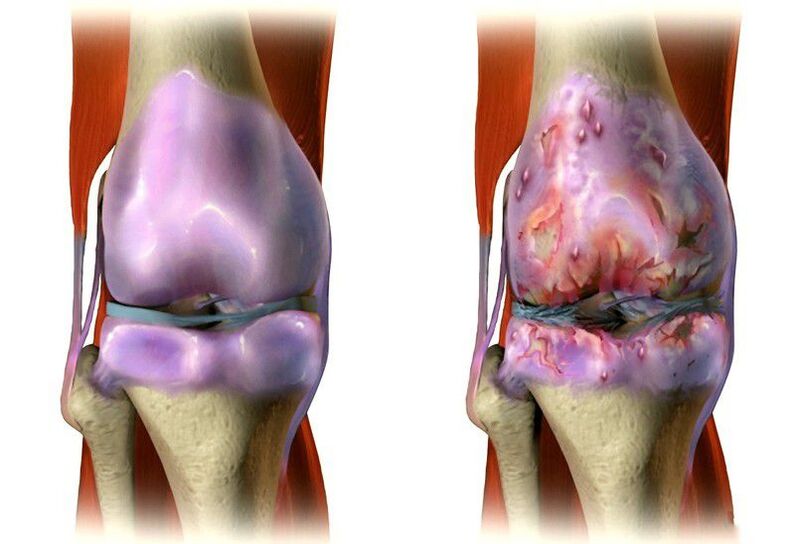
The disease has a chronic course, tends to progress slowly, resulting in overt limitation of joint mobility, impaired joint support function (often both), and pain. Initially, they are dull, painful, drawn in nature, and are especially visible during movements that are accompanied by a crisis in the knee when climbing stairs. However, in the absence of treatment, the cartilage of the knee joints continues to wear out gradually, leading to increased pain and even rest. Later, the destruction of articular surfaces occurs, which aggravates the situation and can even lead to disability.
A typical feature of osteoarthritis of the knee joints is the presence of initial pain, which is necessary for patients to "collapse". Due to this, improvement is observed in 15-30 minutes.
Gonarthrosis is often complicated by the addition of inflammatory processes that can affect the synovial sac, ligaments and tendons. This causes a sharp increase in pain, an explosive nature, swelling of the soft tissues and a local increase in temperature.
Spinal diseases and pelvic asymmetry as causes of knee pain
At first glance, there is no connection between the waist and knees. But in reality this is not the case. They are closely related to the sciatic nerve (nervus ischiadicus), the main nerve of the foot. It originates in the spinal cord and is also made up of fibers that extend from the spinal cord through the natural spaces in the vertebrae of the nerves:
- L4;
- L5;
- S1;
- S2;
- S3.
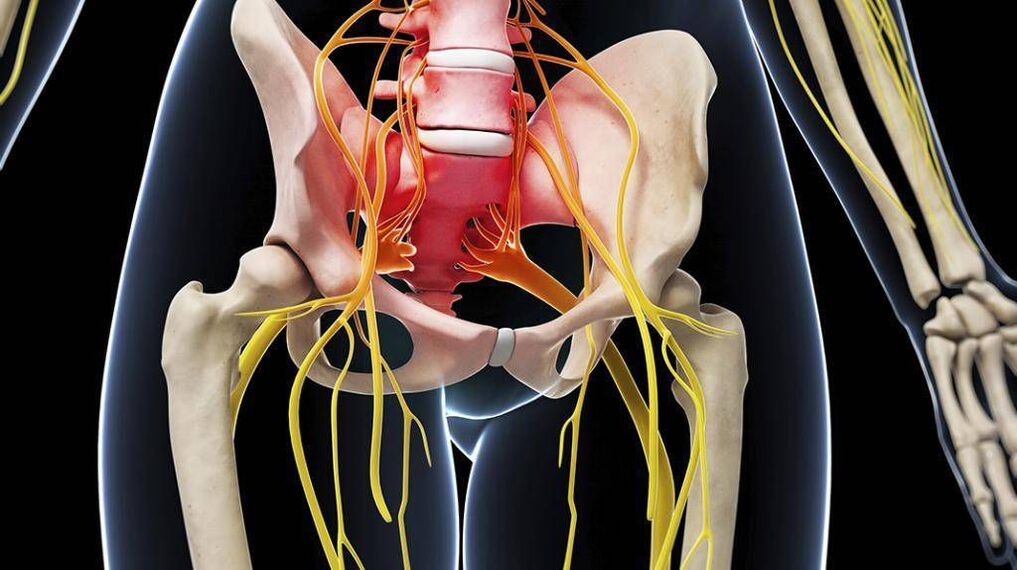
These nerves pass through the vertebrae of the same name and connect to the nerve plexus at the sacrum level. From it, the sciatic nerve separates along the back of each leg and innervates the knee. At the same time, this nerve is responsible for its sensory (sensory) and motor (motor) functions. Therefore, disorders at any point in the transition, especially in the lumbar region, can cause the appearance of pain in the knee. This is often associated with the development of:
- Osteochondrosis, protrusions and intervertebral hernias. These diseases are based on degenerative-dystrophic changes in the intervertebral discs located between almost all vertebrae. They are characterized by a systematic decrease in the height of the disk and its dehydration, which leads to a decrease in the elasticity of its structures and an increased risk of their breaking under load. As a result, the vertebrae become closer to each other, which can cause the nerve roots that pass through them to constrict. If such changes occur in the lumbar region, it is possible to compress the fibers that make up the sciatic nerve, and, accordingly, the appearance of pain in the knee. However, more often this symptom occurs when osteochondrosis is complicated by the formation of a protrusion (protrusion) of the intervertebral disc or a hernia (rupture of the outer shell of the disc), because the protruding areas can compress the spinal roots directly in the spine. provokes the appearance of severe neurological complications, including pain in the spinal canal and knee.
- Spondylosis. It is the most common and chronic disease that develops against the background of osteochondrosis. However, there is an overgrowth of the surfaces of the vertebrae adjacent to the intervertebral discs and the formation of bone protrusions (osteophytes). In severe cases, adjacent vertebrae can grow together, causing them to become immobile and severely constricting the nerves that run through them.
- Spondylolisthesis. This term refers to the pathology of the spine, in which the upper vertebra is displaced relative to the one below it. It is the lumbar region that often causes damage to the nerves that make up the sciatic nerve.

Symptoms that may cast doubt on the cause of knee pain due to lumbar spine pathology may be in addition:
- lower back cramps, aches, sharp pains;
- muscle tension, hamstrings, quadriceps femoris, occupies the entire anterior surface of the thigh and partially the outer side;
- pain and stiffness in the hips;
- widespread pain in the legs;
- pain in the upper thighs.
In each case, the set, nature and severity of symptoms will be different. It mainly depends on the individual characteristics of the organism and the degree of nerve compression.
May indicate direct sciatic nerve failure (symptoms may be observed both in one limb and at the same time):
- pain in the knees, hips and back;
- spasms of the muscles of the back and legs;
- burning behind the foot;
- loss of control over bladder and bowel function.
With dysfunction of the sciatic nerve, there is often a feeling of instability in the knees, their compression. As a result, the patient complains of inability to fully rely on his feet.
Asymmetry of the sacrum and pelvis can also trigger the appearance of pain in the knee joint. This occurs as a result of differences in the length of the lower extremities, which may be due to congenital features or pelvic curvature, including in the background of scoliosis. This leads to overloading of one of the legs and faster wear of the cartilage of the knee joint, resulting in osteoarthritis.
The abdominal muscles attached to the pubic bone are responsible for maintaining the stability of the pelvis. When they are weakened by excess weight, sedentary lifestyle or other factors, the muscles of the back of the thigh are overloaded. This, in turn, causes the knee joint to become overloaded.
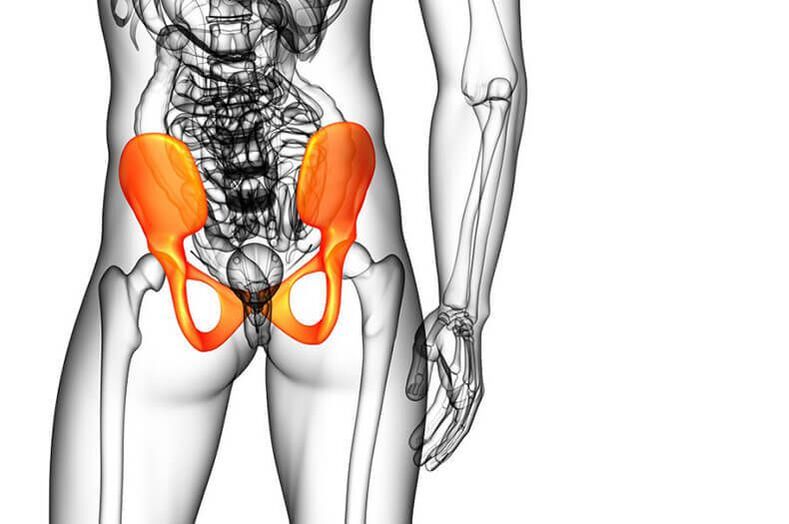
Foot and ankle pathologies
Ankle joints, as well as the knee, can be affected by osteoarthritis. It is often diagnosed in athletes, especially ballet dancers, gymnasts, and the elderly. This leads to a violation of the biomechanics of movements that increase the load on the knee joint and contribute to faster wear. In such cases, a person will be concerned not only with pain in the knee, but also in the ankle, which significantly affects gait due to limited movements.
Foot pathologies, especially flat feet and hallux valgus, can also cause increased load on the knees and cause pain in them. These orthopedic pathologies are very common today and often begin to form in childhood and worsen during adolescence. Valgus deformity is characterized by a violation of the axis of the ankle joint as a result of the inward collapse of the foot. This is associated with increased fatigue in the legs, pain in them, but can later cause pain in the knees.

Diagnostics
If you feel pain in the knee, especially if it occurs regularly or at all times, you should consult a doctor. If the patient has recently experienced traumatic factors, he should contact an orthopedic traumatologist. In other cases, you can first register to consult a therapist. The doctor will assess the patient's condition, collect a medical history and prescribe diagnostic procedures. This will allow him to make an initial diagnosis and refer the patient to a specialist who will be most effective in a particular situation.
However, if a person notices back pain, widespread pain in the leg, burning in the back, or other symptoms described above, you can contact a neurologist immediately. This will save you time and money as soon as possible to determine the true cause of the change in well-being and start treatment. If the patient notices changes in the condition of the feet, in addition to pain in the knee, if he is worried about pain in the ankle joints, it is better to make an appointment with an orthopedist immediately.
In any case, the doctor will study the situation in detail, assess the nature of the complaints and send the patient for examination, which includes:
- laboratory tests (UAC, biochemical blood test) necessary to determine the signs of inflammatory processes in the body;
- Knee radiography in two projections (with suspected pathology of the legs or spine, which are also examined using radiography), which is required to assess the condition of bone structures, as well as to identify indirect symptoms of a disease. number of diseases;
- CT is used for a more accurate diagnosis of joint diseases, as well as the most reliable assessment of the degree of their destruction;
- Ultrasound of the knee joint is used for visual assessment of all structures of the knee, their size, position;
- MRI is currently the best method for diagnosing various pathologies of soft tissue structures, including cartilage of the knee joint and intervertebral discs.
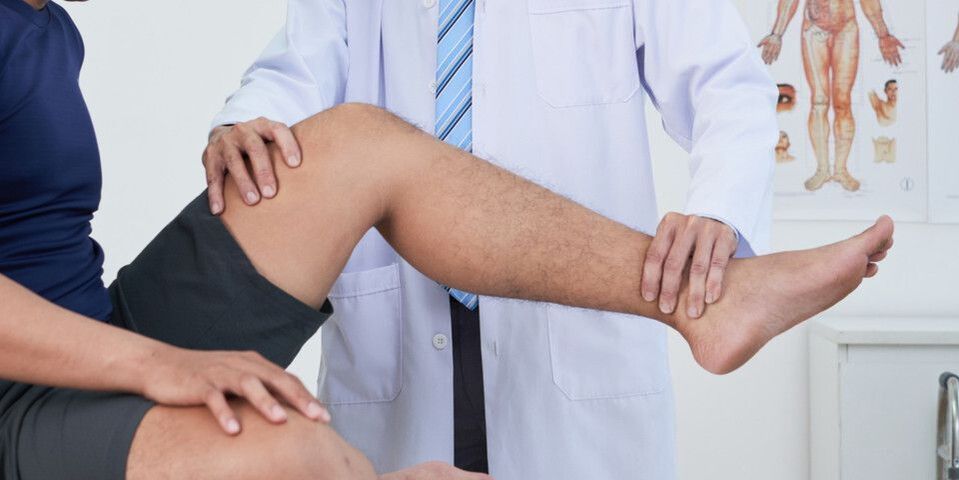
In some cases, patients may be prescribed arthroscopy, an invasive method for diagnosing and treating knee joint pathology. As a rule, severe osteoarthritis and ligaments, menisci, etc. required for traumatic injuries.
Treatment
Because there are many diseases that can manifest themselves as knee pain, there is no single treatment strategy. In each case, it depends only on the nature of the pathological changes, their severity, the presence of accompanying pathologies, the individual characteristics of the patient, age, and so on.
In the case of pathologies of the spine that cause pain in the knee, treatment is carried out under the supervision of a neurologist. If they are the result of osteoarthritis, knee, ankle joints, other pathologies of the legs, treatment is prescribed by an orthopedist.
When diagnosing spinal or pelvic bone pathologies, patients may be advised to visit an endocrinologist to help them deal with their excess weight, in addition to consulting a neurologist.
All patients with spinal diseases, orthopedic pathologies, including osteoarthritis of the knee joints are treated comprehensively, including:
- drug treatment;
- physiotherapy;
- exercise therapy;
- hand therapy.
Each measure is carefully selected individually according to the degree of indifference to the diagnosis and pathological changes. And plasmolifting with osteoarthritis of the knee joints of 2-3 degrees is often prescribed in addition.
Medical therapy
Drug treatment usually covers 2 areas: symptomatic and etiotropic therapy. The first is aimed at improving the patient's well-being as soon as possible, relieving knee pain and other existing symptoms. The purpose of the latter is to directly affect the cause of the development of the disorder and the normalization of the patient's condition over a long period of time.
Therefore, in most cases, patients are prescribed a complex of drugs:
- NSAIDs are a symptomatic therapy that allows you to quickly stop pain in the knees, back and legs and have an anti-inflammatory effect.
- Corticosteroids are powerful anti-inflammatory drugs that are indicated for severe inflammation and are most commonly injected into the joint cavity. Applied in short courses.
- Chondroprotectors are products that contain components used to repair cartilage tissue. They are usually prescribed in long courses lasting at least 2-3 months.
- Muscle relaxants are medications prescribed for spasms of the back and hip muscles, which are often a reflex reaction to the body's pain impulses.
- Vitamin complexes are drugs indicated to improve the course of metabolic processes in the body, as well as to transmit bioelectric nerve impulses along the nerves.
Plasmolifting
Plasmolifting is the injection of plasma from a patient's own blood directly into the injured knee joint or surrounding soft tissues. Due to the saturation of blood plasma with platelets, cytokines and growth factors, it helps:
- stimulating the flow of natural regeneration processes;
- restoration of normal synovial fluid composition and volume;
- activation of blood circulation and nourishment of joint cartilage;
- elimination of inflammation;
- painkiller;
- restoration of normal range of motion in the affected joint;
- reducing the duration of treatment by 2-3 times.
PRP-therapy, called plasmolifting, perfectly complements the treatment of osteoarthritis of the knee joint, so it is often included in the treatment regimen of this disease. It can also be used in the treatment of osteochondrosis and injuries of the spine, to supplement medication, physiotherapy, exercise therapy and other treatments.
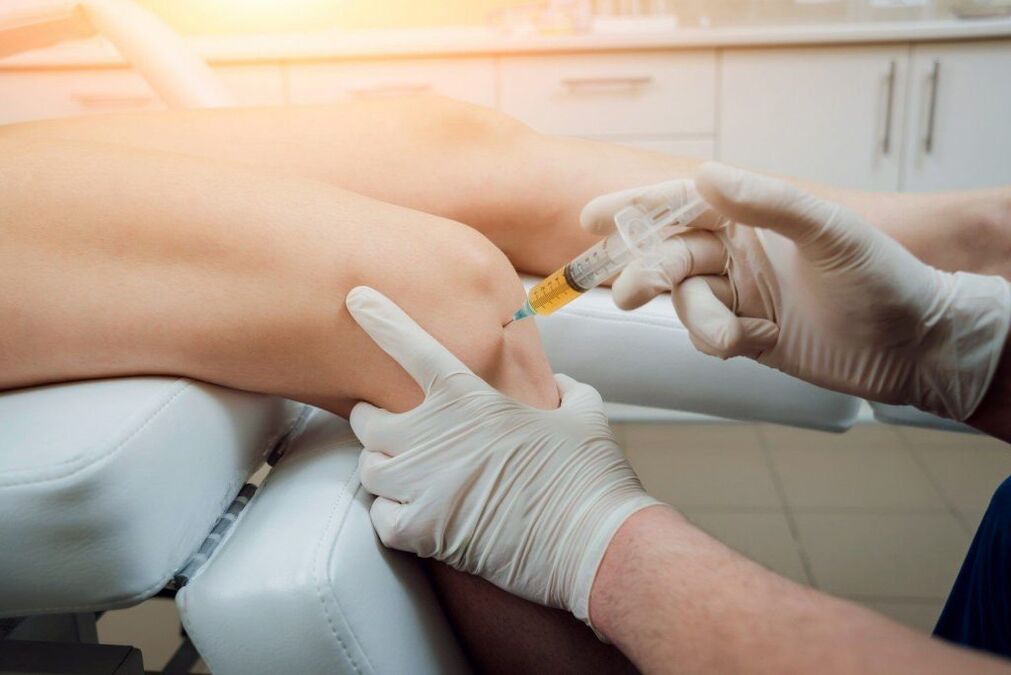
Physiotherapy
Different types of physiotherapy procedures can be used to treat diseases of the musculoskeletal system that cause pain in the knees. They increase the effectiveness of other treatments and have a positive effect on the affected area. Physiotherapy is always prescribed in 7-15 course courses selected individually. They often seek help:
- magnetotherapy;
- ultrasound therapy;
- UHF;
- phonophoresis;
- electrophoresis;
- SMT therapy or amplipulse therapy;
- vibration massage.
exercise therapy
Physiotherapy exercises play an important role in the treatment of joints of any localization, and especially pathology of the spine. Dosage allows you to increase the range of motion, as well as stimulate blood circulation, which activates the nutrition of all structural elements of the knee joints, thereby helping them to recover.
But in this case, it is important to choose the optimal set of exercises that will be most useful and will not hurt. Patients may be recommended stretching exercises, which are especially important for spinal pathologies. Also, exercises to strengthen the musculoskeletal system are almost always prescribed. They will reduce the load on the affected joints and contribute to the formation of a strong muscle frame, which creates favorable conditions for their recovery.
Physical therapy classes are simple and accessible to people of any age, as an individually designed program creates a dose load that has a positive effect on the patient's joints and eliminates exercises that can be harmful. However, in order to master the proposed training methodology as accurately as possible, it is worth conducting the first lessons under the supervision of a training therapy instructor.
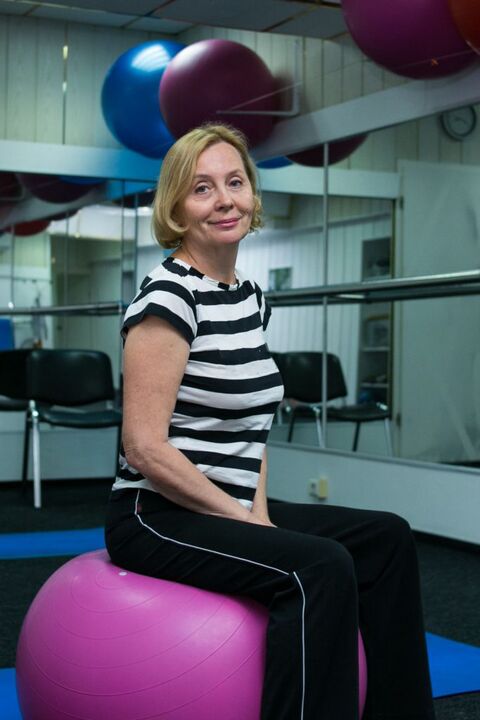
In the future, you can exercise at home, in nature or any other suitable place, but on a daily basis. Systematicity is one of the main rules for the success of physiotherapy exercises. Therefore, it should be added to the list of daily activities and given the necessary time - usually 20-30 minutes is enough. It is important to avoid sudden and hurried movements during lessons, as this can cause pain and make the condition worse.
Manual therapy
Manual therapy plays a key role in the correction of pelvic asymmetry and the treatment of spinal diseases. It involves an in-depth study of the back muscles, ligaments and joints of the spine, the pelvic region with the hands of a specialist. There are many methods and techniques of manual impact. They are selected depending on the type and severity of the existing pathology.
Thanks to the course of manual therapy sessions, it is possible to do the following:
- relieve back pain by reducing pressure on nerve fibers;
- to improve the nutrition of all structures of the spine due to the activation of blood circulation;
- increase spinal mobility;
- improving posture by eliminating spinal deformities;
- To restore the normal condition of the pelvic bones and internal organs, has a positive effect on their activity.
However, for patients with knee pain, the most important effect of manual therapy is to relieve the compression of the sciatic nerve and the fibers that make it up. This leads to a progressive improvement in the condition and the elimination of pain syndrome, as well as other neurological disorders.
Patients feel the first positive changes after the first session. Additional procedures help it to grow and stabilize for a long time. The first procedures can be performed only after the elimination of acute inflammation with the help of medication, physiotherapy and other treatments.
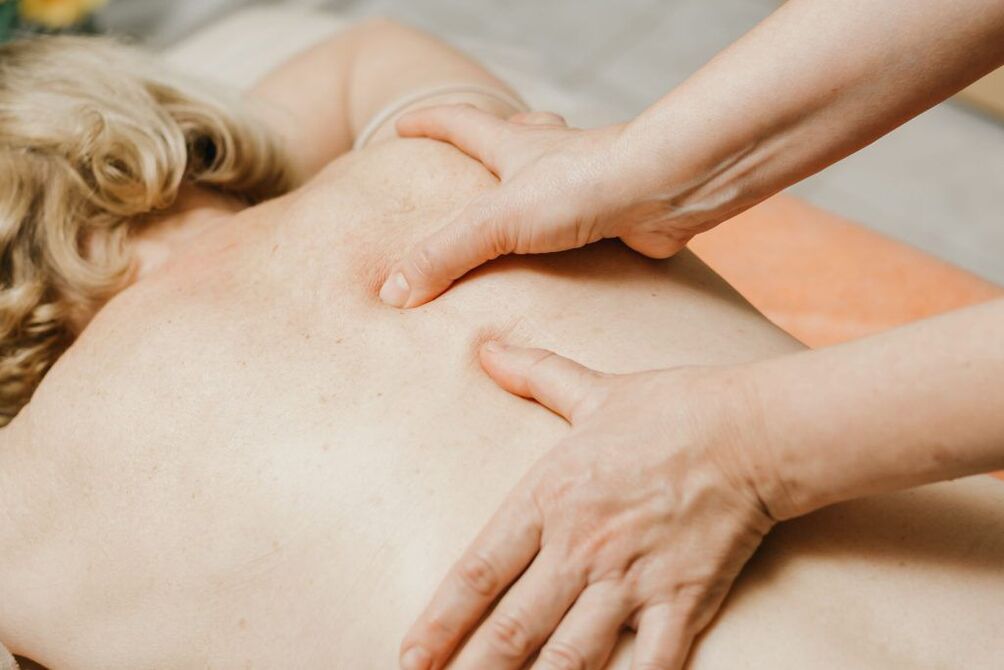
Thus, pain in the knee can indicate not only its defeat, but also the appearance of problems in other parts of the musculoskeletal system, especially in the spine and legs. In any case, it is impossible to ignore them, because existing pathologies tend to progress over time in the absence of competent treatment. This will increase the severity of the pain, cause other unpleasant symptoms and, in general, reduce the quality of human life. Therefore, if you have discomfort in one or both knees, you should consult a doctor: orthopedist or neurologist. Timely treatment at an early stage in the development of pathological changes will allow them to return and completely restore normal joint function, providing freedom of movement for many years.
































